Subtitle: How to do it, and why you may not want to
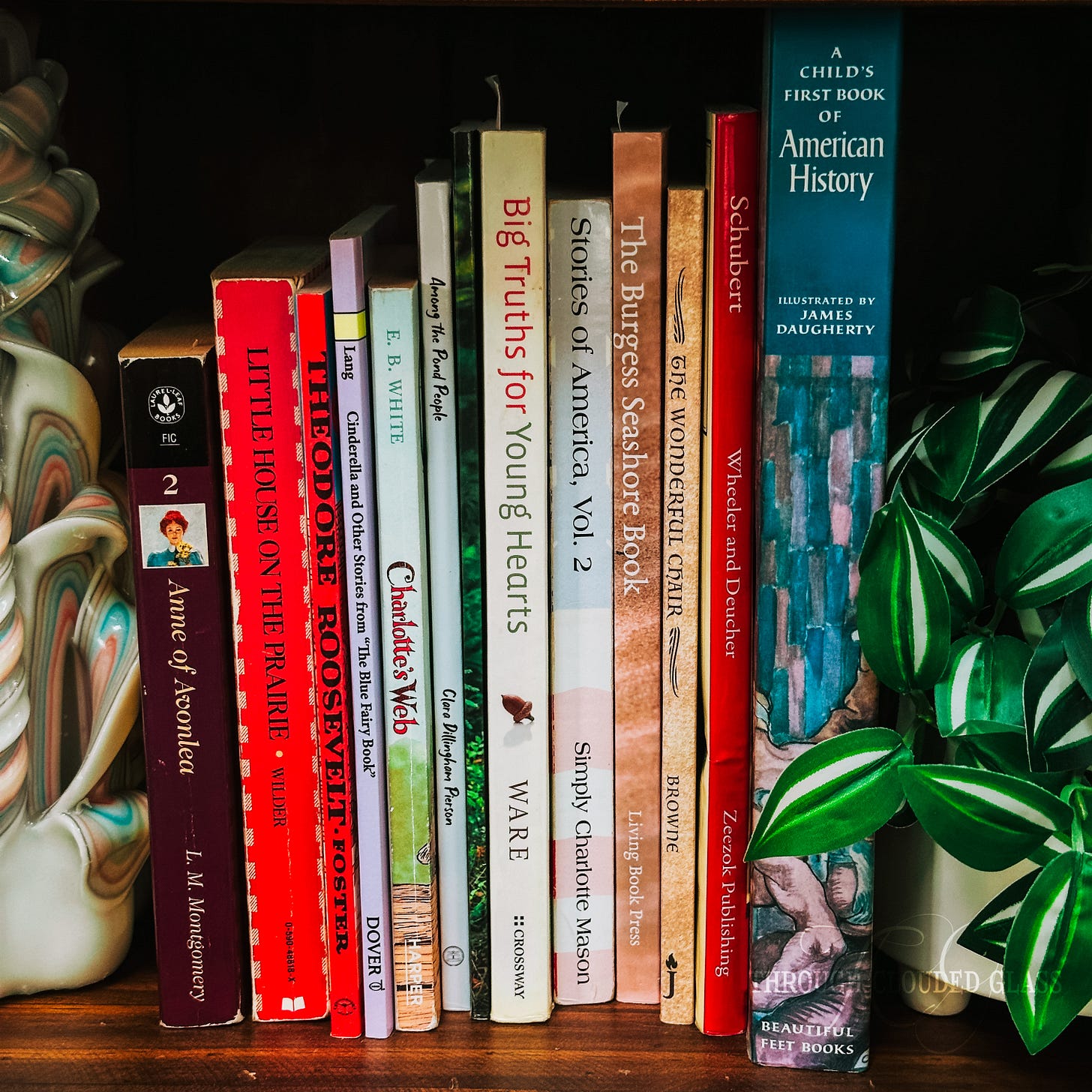
(The quintessential stack of homeschool read-alouds. These are about half of the books we went through this year.)
How can I help my kids learn to work more independently?
I’ve heard that question so many times, in conference talks, online forums, from friends, and from my own lips. Developing independent learners is something homeschool moms, especially moms of multiple kids, think about a lot.
I remember many days, collapsing into bed exhausted after being pulled in multiple directions all day, and wondering how long I could keep doing this. Helping my kids learn to work more independently became a crucial concern, like it would be the life or death of our homeschool. Now, as my oldest prepares to enter high school, I’ve seen him grow leaps and bounds in working independently, and I’ve learned a few things about helping kids be more independent. I’m sharing practical suggestions and a little straight talk.
1. Don’t push for independence too early.
When my kids were still in elementary school, in a desperate bid to find something my kids could start to do without me, I gave my older kids a workbook for language arts. When I had to be busy with another child, I would ask them to pull these workbooks out for some independent work.
At first the year seemed to go along swimmingly, but eventually I realized that while my kids were progressing to the next lesson each week, they still could not tell me the parts of speech. When we had a minor existential crisis over writing a poem, I realized that what I thought was independent work was really just busy work. In order for my kids to really learn what the workbooks were trying to teach them, I would need to sit down and go over everything with them step-by-step.
On top of that, I had wasted valuable learning time during that homeschool year when a little more effort from me up front would have set a stronger foundation. My kids were not ready to be independent, and that was normal, and I had to learn to accept it.
I think a mistake that we often make is pushing our kids to be independent in their school work too early. Some kids are naturally more independent and make homeschooling look so simple, but we need to be careful of even putting those kids into the “independent” category too quickly. Our kids may appear to be making progress, but if we never sit down and watch them do their work, we can’t really know if they are learning something, or if they are just pushing ahead in the book even when they don’t quite understand a concept. It’s our job as the homeschool mom to help them actually learn, not just get through a workbook. In the younger grades, kids need a strong foundation of understanding, through a lot of help from mom, so hopefully they can be solidly and truly independent in the older grades.
2. Start with checklists.
Once your child is at an age where they can reliably manage their own work - this usually comes in stages, so probably just one or two subjects at first - consider helping them stay on track with daily checklists.
Before I developed our checklist system, I’d often be working with one child, and another would interrupt to ask what they should do next. “I don’t know, go start on your next subject,” ended up being my vague default response - and my poor child, who still didn’t know what to do, would end up deeply invested in a lego game with a younger sibling instead of accomplishing anything.
Eventually I realized that we needed to break out of that habit, and one summer I created a document with a weekly checklist for each child, with all their subjects broken up into days. It looked something like this:
Monday:
-Math lesson -Grammar book -Copywork -Writing video (with sibling) -Read history
Tuesday:
-Math lesson -Grammar book -Copywork -Write outline for paper -Read science lesson
Wednesday:
-Math lesson -Latin -Copywork -Write first draft -Read history -Work on Awana book
Thursday:
-Math lesson -Latin -Copywork -Finish paper -Read science
Friday:
-Math lesson -Art lesson -Copywork -Type up paper -Science experiment with mom
That’s a very simplified example, but you get the idea. I have checkboxes next to each task, and once the checklist are finished, my kids know they are done for the day. I think it is motivating for them to see how much is left and to know they are making progress. It helps prevent wasted time since they always know what else they can work on by themselves (I will sometimes highlight their independent subjects a different color from the ones they need my help with). I even print these checklists for my little girls, but I am the one who manages the checklists for them, since they still need my help for nearly everything. The checklists keep me on track too.
3. Map out the year.
You can’t expect to just hand a child a homeschool curriculum and have them proceed without any help or direction from you.
A couple years ago, as my son entered middle school, I started having an “orientation day” with him toward the end of summer. We sit down with his school books and a calendar, and I show him how many lessons are in each book, how many days we have in the school year, and how many lessons he would have to finish each week to stay on track. I sometimes even write up syllabi and expectations for each homeschool subject - which is helpful, but you don’t necessarily need to go that far.
What I am trying to accomplish with our orientation days is teaching my child how to look ahead at the whole year, and provide checkmarks for them to be able to easily see that they are staying on track. It’s really teaching them how to plan by holding their hand through the process. Some kids may catch on quickly, and for most kids you’ll have to repeat this process every year until they can naturally take it on themselves. I think middle school is the best time to start this - remember, not expecting too much too early, but hopefully helping them learn more planning skills before they reach high school.
4. Remember that independence does not mean mom can be hands-off.
Another mistake I see in homeschool circles (and that I have made myself) is the tendency to become a little slack on checking up on your child once they have reached a certain level of independence. This is how you reach Christmas break and take a peek inside your child’s Latin workbook only to realize they are two months behind (ask me how I know).
Even if your child is on the correct lesson number, remember that it’s still your job as a homeschool mom to make sure the understanding of the subject is there. You should frequently ask your more independent child about what their science book is covering right now, take a peek into their workbooks often, make sure you are grading their papers and tests so you can help shore up any areas where they are struggling. Be ready to answer questions, edit their papers together so they can learn how to improve their writing, and expect to have to research the answers to confusing math questions.
If you find yourself never doing any of these things, I’d encourage you to check yourself. Are you too busy with your own projects or outside commitments to make sure your kids are progressing as they should? Are you spending too much time on your phone, and not enough time enriching your child’s homeschool experience by actually talking with them about what they’re learning?
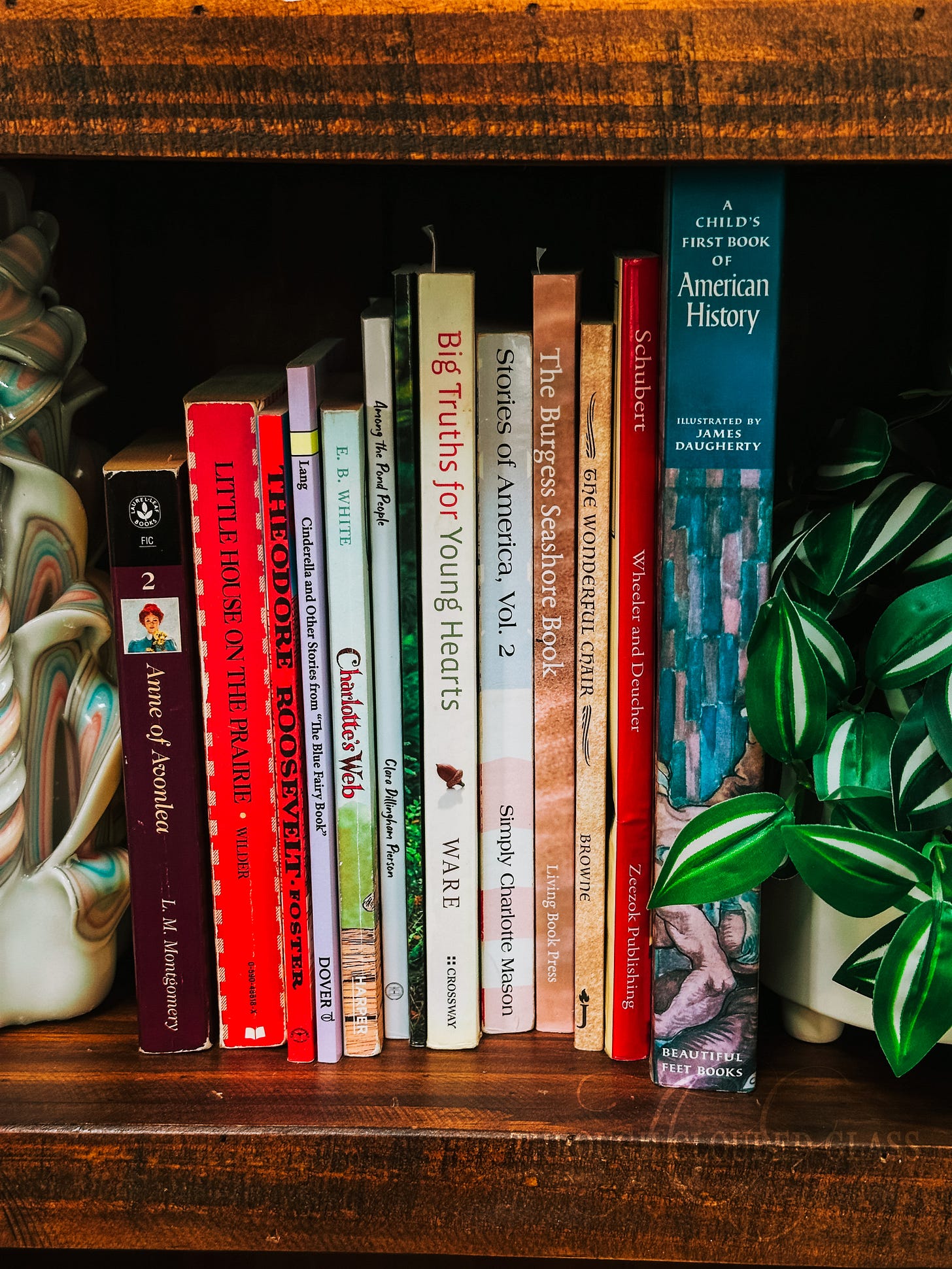
The truth of the matter is, there really is no point when a homeschool mom can just lean back and rest on her laurels, until her kids are graduated - maybe not even then. Homeschool students are always going to need help, direction, tips, discussions, and check-ins with mom. These things aren’t a chore, but an opportunity to pour into and connect with our kids through their education. Don’t wish those tasks away - don’t push your kids too much to not need you. They do need you, you are their best and only teacher, and being there for them is the beautiful thing about homeschooling.
I’d love to hear any more tips or encouragement you have on this subject! Comment below.

On The Page {Anything I’ve Read}
This particular morning, I spent a good amount of time reading blogs and Substacks, and I forgot how much I enjoy getting a peek into different people’s lives and thoughts. I have found so much encouragement and refreshment in small blogs that most people have never heard of. This reflection on a passage from The Great Divorce was especially lovely today.
I am plugging away at a sci-fi time travel book at the moment, and I won’t mention it yet because the jury is still out on whether I’m going to recommend it. Aside from that book, I find myself listening to books more than reading this week. On rotation are: Where The Water Goes (about water management in the western U.S., which sounds boring but isn’t), Midnight In Chernobyl (still working on this one), and Old-Fashioned On Purpose (which I just finished).
In My Armchair {Projects I’m Working On}
In the last month I have returned from a lovely trip visiting our friends in Kentucky, then spent two weeks being a little lazy and recovering, then I jumped right into attending our local homeschool conference and VBS at our church. So I haven’t had the space or energy to tackle any major new projects yet this summer…aside from looking at curriculum and trying to think through how I will teach the history class at our co-op this fall. Important things, but not particularly fun to share.
In The Kitchen {Things We’ve Made}
I’ve been experimenting with new recipes here and there, inspired by a high-protein cookbook I rented from Amazon. I made lemon shrimp and pesto noodles; a sweet potato, beef, and pepper braise; and a greek chicken quinoa bowl.
The last one was the biggest hit, and the first time I’ve attempted making quinoa anything. I don’t have a recipe - basically I cooked up the chicken and made the cream sauce using a spice mix from Walmart, cooked the quinoa, and threw it all into a bowl with greek olives, sun dried tomatoes, cucumbers, and feta cheese. It was delicious.
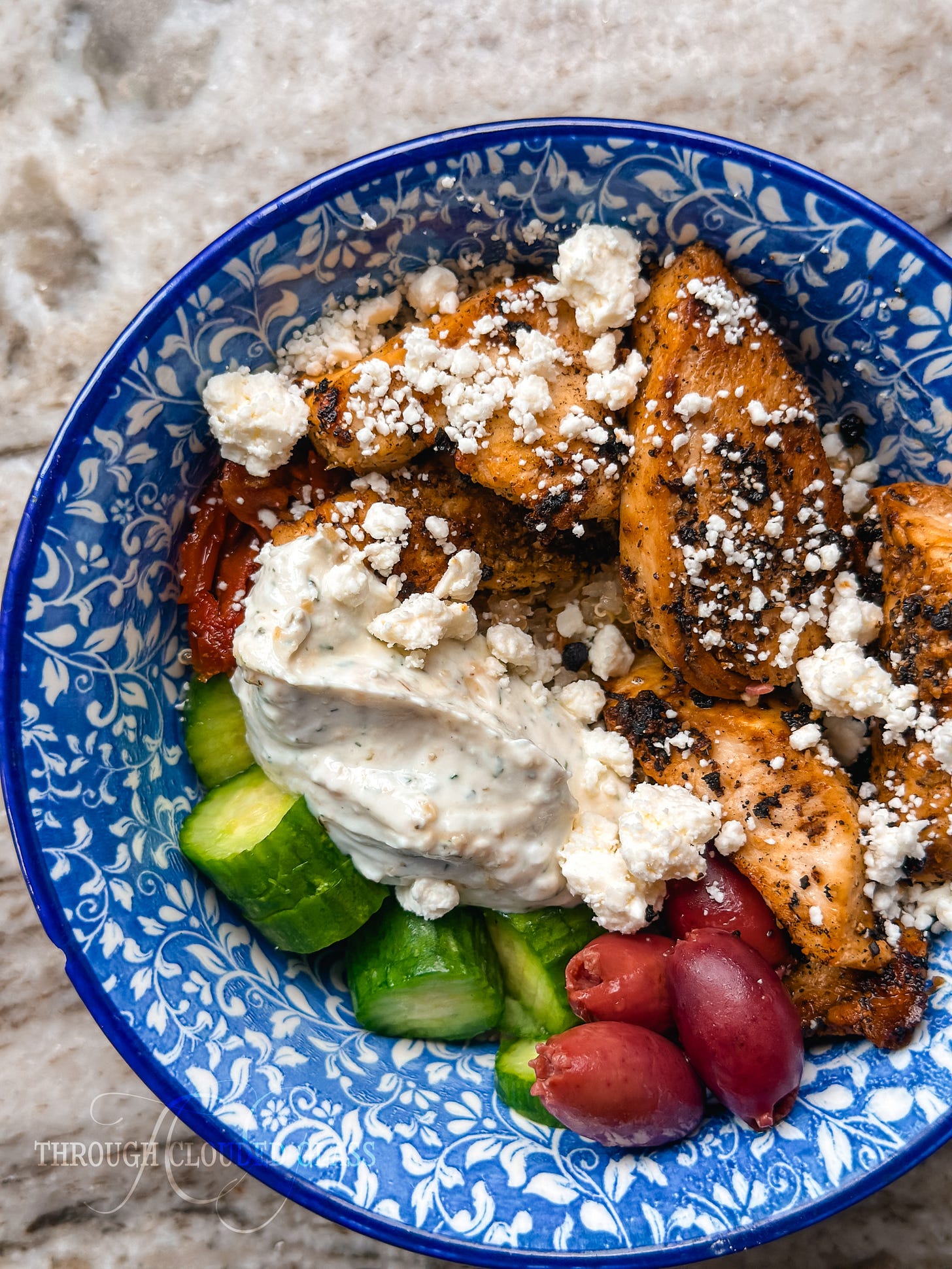
On My Person {Things I’ve Worn}
It has been a cooler start to the summer, so I haven’t fully embraced my summer wardrobe yet - I also have been not the best at taking outfit photos over the last month, so these few will have to do.
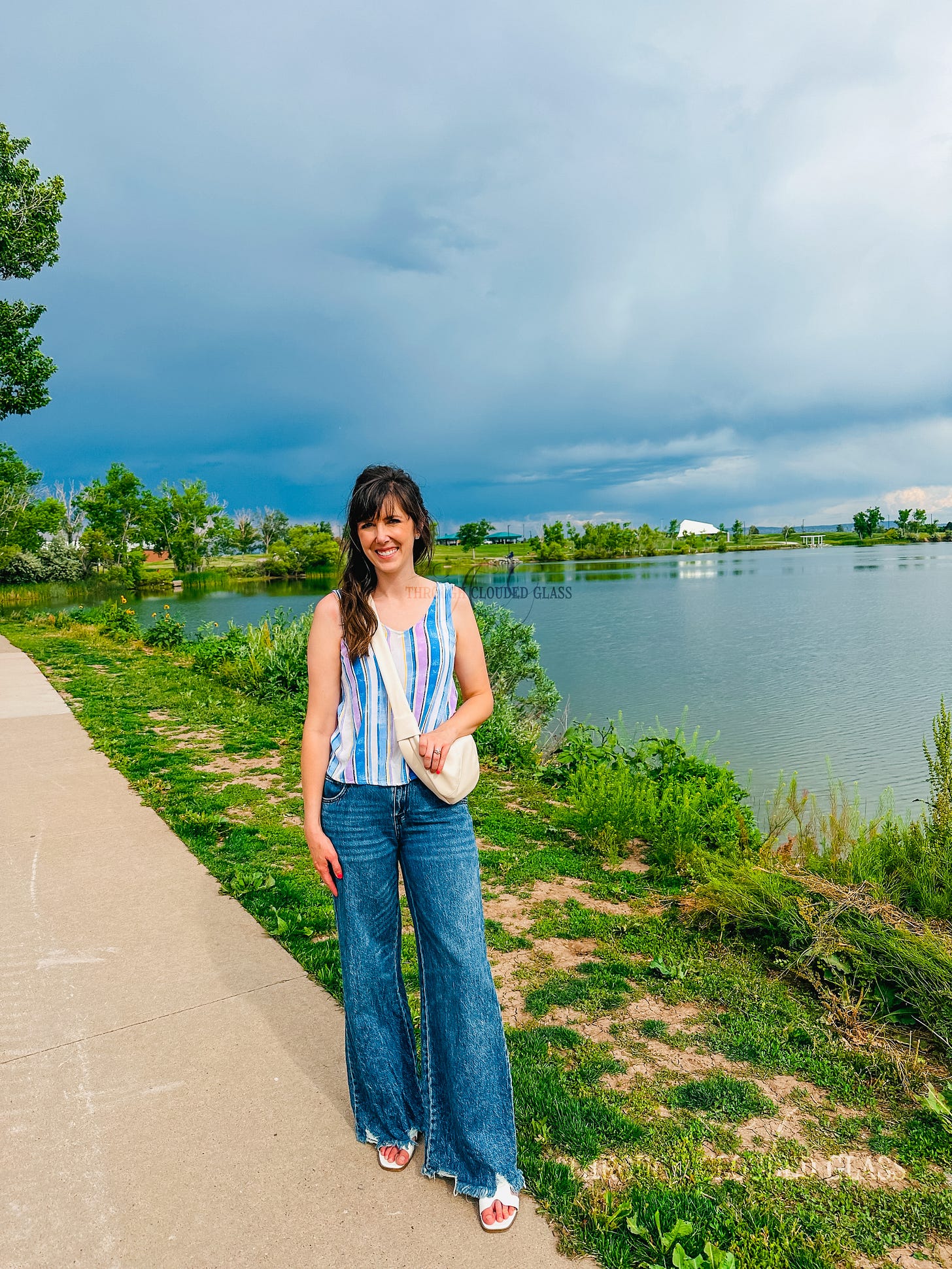
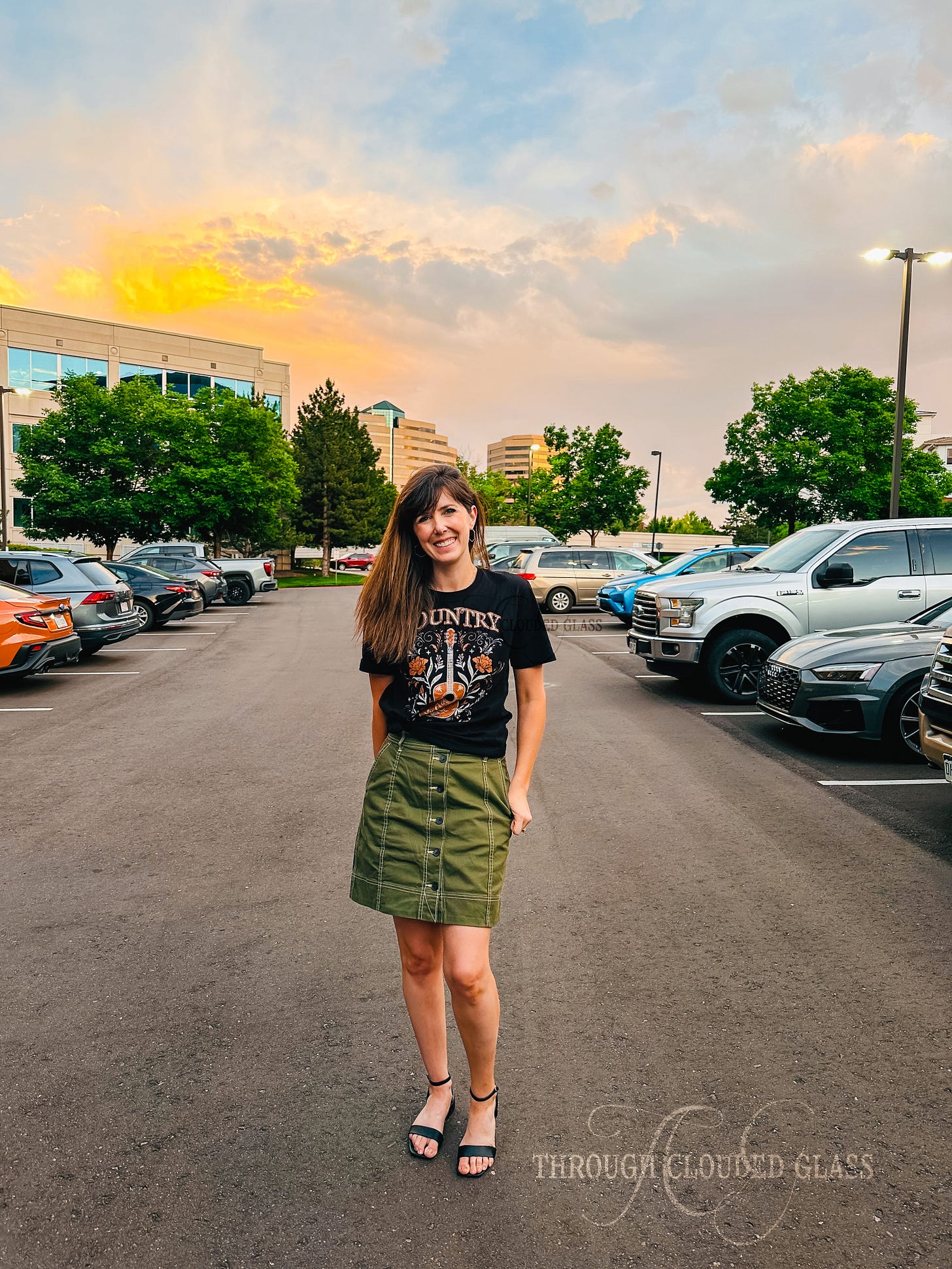
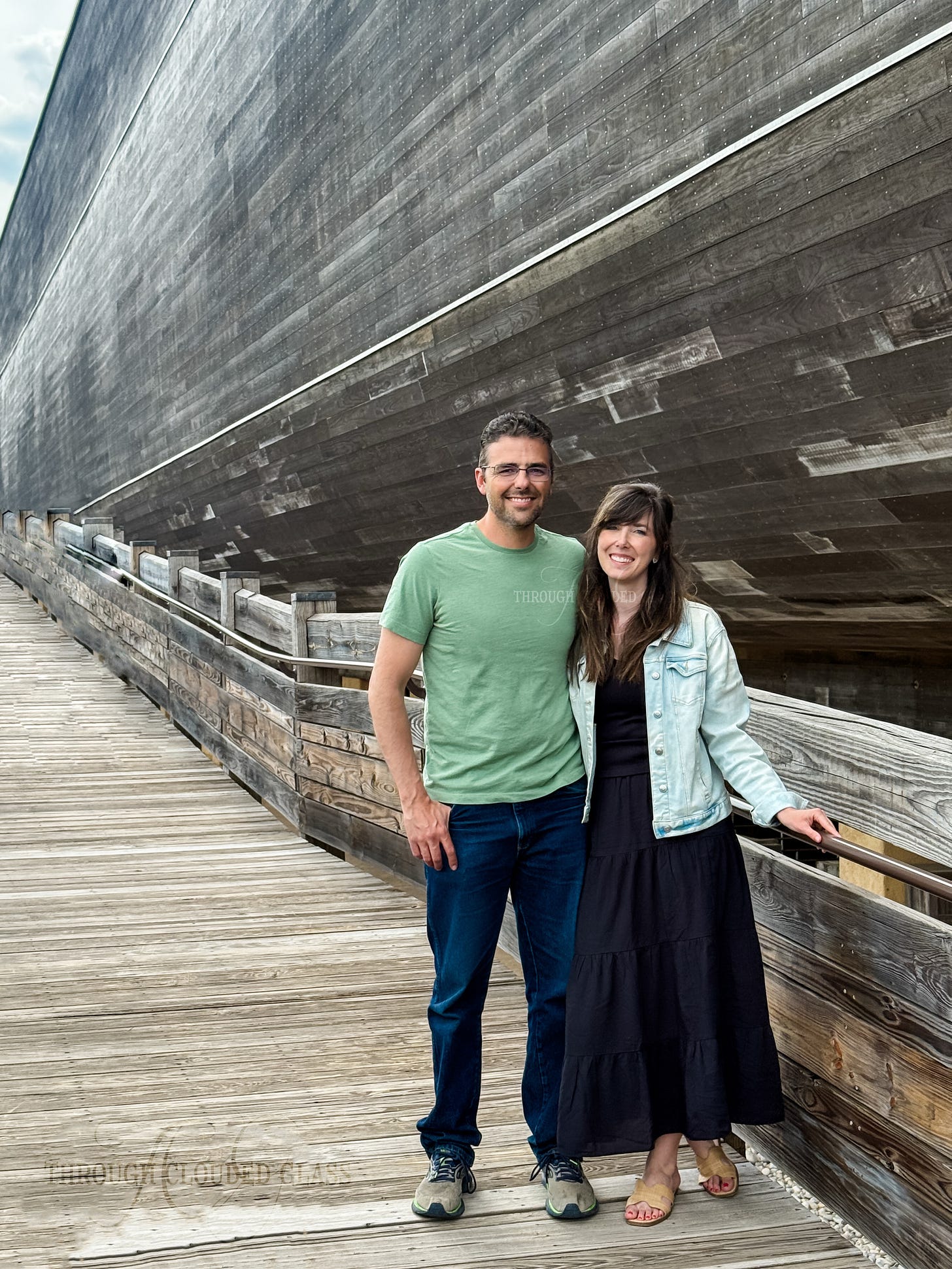
In The Accounts {Money We’ve Saved}
Alas, I have done a terrible job of saving money this month. June is always one of our worst months of the year for spending. We have multiple birthdays and events, and we spend more in gas than usual. But…
-I did a decent job of packing us lunches or scrounging for snacks instead of eating out.
-I received free food items through app promotions.
-I started using Upside again to get cash back on gas purchases, and I’m well on my way to earning enough for a museum membership.
-My eyesight has apparently devolved to the point that my contacts are now considered “medically necessary”, and hence are covered by insurance! So instead of paying $400 for a six-month supply, I now pay $15.
-I got a drawing book I have been eyeing for my birthday, so now I won’t be tempted to buy it myself.
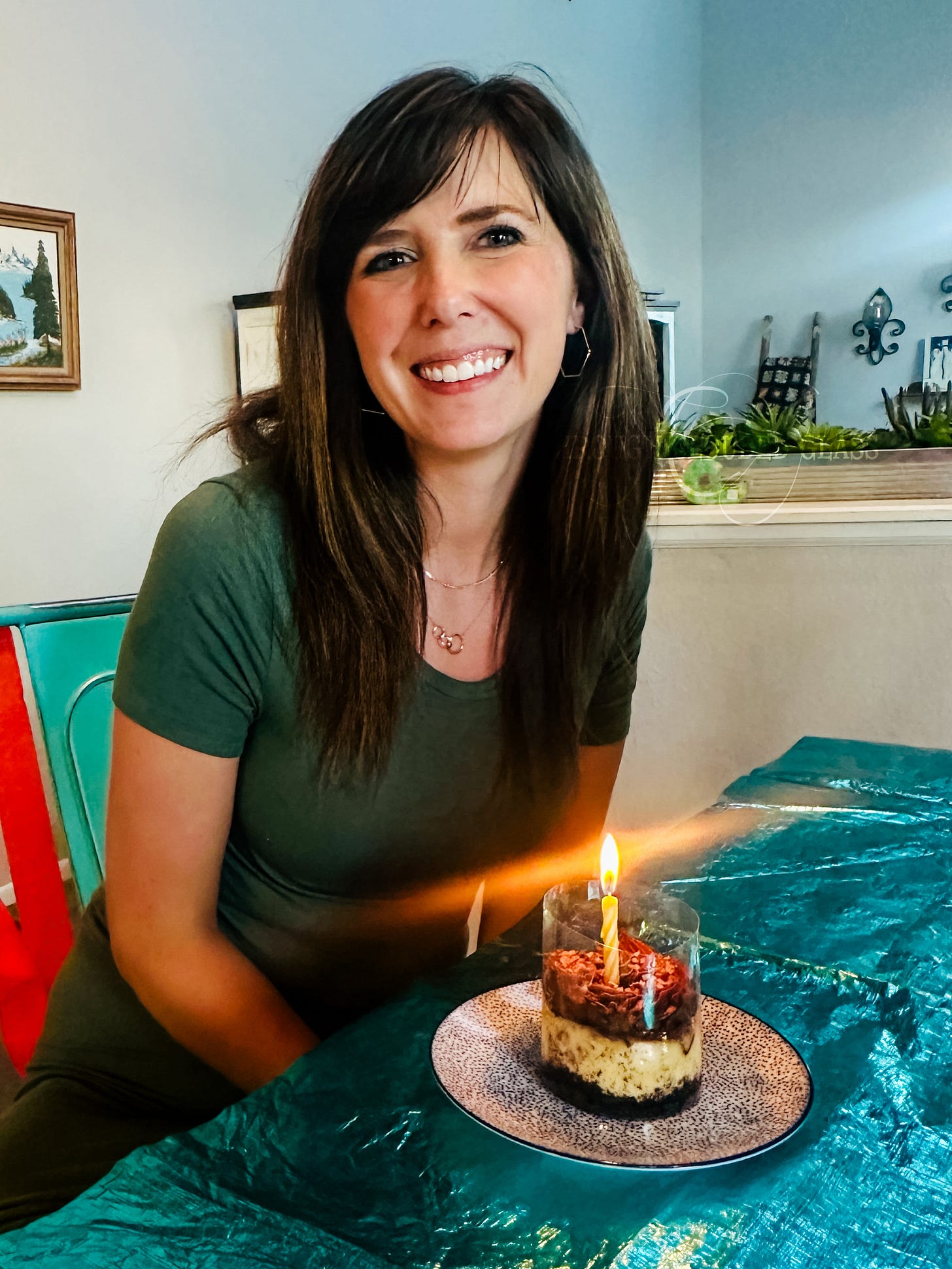
Out My Window {Beauty I’ve Noticed}
Our lilac bush bloomed for the first time in several years, and it’s completely loaded with blossoms! Unfortunately, pine tree pollen season has also arrived in the mountains, and everything is coated with pollen now, giving the blossoms a greenish yellow hue. I am looking forward to a couple rainy days next week to hopefully clean off my beautiful lilacs. Do people cute lilac blossoms for vases, and if so, do they last indoors? I am contemplating researching this, because I would love to bring them inside.

The wildflowers are also in rare form this year.
Out And About {Places We Went}
Homeschool Conference - We attended our state homeschool conference, and I was not very excited about the speaker list this year. However, I sat down in my first workshop session, and the speaker was just chatting and giving little freebies before really getting into her talk, and one of the things she said spoke straight to me heart. It was exactly what I needed to hear, and I felt tears spring to my eyes. Several speakers after that providentially addressed things I had already been contemplating, and I was reminded that the Lord knows what I need better than I do. I was so thankful for all of these faithful homeschool speakers that most people have never heard of.
Vacation Bible School - This post is brought to you by my church’s VBS. Last year I volunteered, but it was exhausting right on the heels of attending a 3.5 day homeschool conference, and I was such a mess I implored my husband to forbid me from volunteering for VBS the next year. He kept his end of the bargain, so I find myself with a couple hours to myself every day this week, and I don’t feel sorry about it. Sometimes we homeschool moms are with our kids so often (and that’s on purpose), we forget it’s okay to sometimes intentionally not be with them, just for a little bit to refresh. It’s been helpful for me to have some alone time this week to reflect on the conference and my hopes for the coming year.
Swim Park - This activity is on the calendar. Don’t tell my kids, it’s a surprise.
On My Mind {Thoughts To Share}
About halfway through the year now, I can confidently say that the thing the Lord is prompting in me is becoming more faithful in prayer. I will write more about this soon, but prayer has been a struggle for me for years now, unless I am having some sort of crisis, and I know that this should not be the case. Last week, speaker after speaker spoke about the importance of prayer, and one of them said that as our kids’ parents, we should make sure no one is praying for our own kids more than we are. That’s saying something when you have faithful praying grandparents in the mix! But it was a good challenge for me to be more intentional in praying for my kids, and our homeschool, and my husband, and our church.
In My Heart {Things I’m Treasuring}
-Warm weather and sunshine
-The occasional rainy day to hold off wildfires
-A house I love, even when it needs cleaning
-Kids who would rather play outside or make things than stare at a screen
-Friends who care enough to check in or smuggle your birthday present into the homeschool conference
-a free drink for downloading the Dutch Bros app
-Happy music
-Hearing baby birds hatch from their eggs outside our bedroom window (it was at 4AM, which was not appreciated, but it was still sweet to hear the chirps).
Our lilac bush, which has not bloomed in three years, came to life with flowers this year. As I was choosing a photo for this post, I remembered the too-many photos I took of the lovely blooms, and it struck me that our lilac bush feels like a fitting metaphor for our homeschool season. After two years of struggling through our homeschool days, somehow as we close out this year I find myself less burned out and more excited about homeschooling again.
Often when I write these “lessons learned” posts I’ll have some general principles and advice mixed in with my points, but I don’t have any this year. The changes we made were unrelated to any specific challenges we had, but ended up shifting our homeschool dynamic in unexpected ways.
Last year I ended the year struggling hard, and the fact that this year was better is probably a mix of the changes I made and also just entering a different season with my kids. I don’t think if you are struggling you should do the same things we did this year - but if you are struggling in your homeschool, make the changes YOU need to make to feel excited about homeschooling again. Don’t be afraid to try something new, because sometimes it ends up being just what you needed.
These are the two new things we did that breathed some life back into our days.
1. We started a new Charlotte Mason curriculum for history, geography, and literature.
We have been doing Masterbooks for history since the kids were small and to be clear, we have loved it! But after going through the same books several times now, I was ready to try something else. I heard about a reformed protestant Charlotte Mason curriculum that was in its beta year, called Living Heritage, and I was intrigued. I liked a lot of the books on the lists and the layout of the curriculum, and I decided we would give it a try.
I have been familiar with Charlotte Mason’s philosophy for years, and we have incorporated some of her principles (such as narration), but this was our first attempt at a full Charlotte Mason approach for certain subjects. We followed Living Heritage Cycle 4 for history, geography, art and music, and literature (with one or two science books as well).
Living Heritage ended up being a success for all my kids. I saw them grow leaps and bounds in their abilities to recall information from the readings, and in their writing endurance (for my older kids). We had zero complaints about any of the books (except my boys making fun of the opera stories we read), and my older kids asked to continue reading “real books” for history next year too.
Since we have never done another true Charlotte Mason curriculum, I can’t compare it to the big curricula, like Ambleside Online or others. It’s my understanding that there is some crossover in the booklists. What I appreciated the most about Living Heritage was the Bible, which is treated as a full and important subject. The books under “Bible” were so rich and theologically deep. I was especially nervous that the 8th grade Bible read would be too tough for my oldest, but I was pleasantly surprised at how much he understood and retained. It taught me that I shouldn’t underestimate my kids’ abilities to understand and enjoy even hard books.
This ended up being one of my favorite years of our homeschool, but not because it was easy. We combined Living Heritage with other curricula for science and math, as well as different “spine” books for our co-op classes. It was challenging to balance everything we were doing, but I think it stretched and grew my kids, and raised my own confidence in what we can accomplish if we manage our time well. We spent a lot of time on meaningful learning, and it wasn’t a burden to me or the kids because we really enjoyed so many of the books.
I did make adjustments as we went - I dropped one classic that was proving too much of a burden, and a couple books slipped off the list merely because of time. But when I look at the stacks of books we did read, I’m left with alot of satisfaction. We will adjust the curriculum to work with our high school plan for the fall (I still can’t believe my oldest is in high school), but it wasn’t even a question that we would be doing Living Heritage in some form again. You can check out Living Heritage here.
2. We rejoined a local co-op.
After taking a four-year break from any kind of co-op group, we re-joined a local co-op this past fall. We were part of this same group when my oldest was in 3rd and 4th grade, but at that season of life with young kids, I found it too challenging to attend a weekly co-op. I was floundering and recognized I need to spend some time developing my own homeschool discipline and direction before considering a co-op again. My goal was to wait until my youngest had learned to read - and after she finished her kindergarten year, we visited the co-op again.
The timing was right for us to give co-op a try for multiple reasons. My kids were more academically independent, we had good homeschool routines established, and my youngest was reading. Over the past several years we also had several of our core homeschool friends either move away or stop homeschooling all together, and we were in a place of needing a group we could connect with locally.
It’s been new for me to balance having a vision for our homeschool days at home and keeping up with our co-op work, but it helps alot that our co-op is mom-run and flexible. All the kids’ co-op leaders are also homeschool moms with their own things going on, and we recognize that mom makes the final call on what work needs to get done and when. My kids get the most out of it when we stay on schedule with co-op, but if we have a bad week or choose to drop an assignment in favor of something else, we have freedom to make adjustments.
Socially, it’s been a lovely thing for the kids, and I don’t take it for granted. They have made friends, they have just the right balance of structure and visiting time, and the kids in this particular co-op have seemed to mesh together very well. It was what we needed this past homeschool year to keep us encouraged.

Most homeschool moms would tell you that you often have to re-learn how to homeschool every year - there are always new challenges and adjustments that need to be made! This year we took a risk on changing our homeschooling style for over half our subjects with Living Heritage, and adding a big item to our weekly schedule with co-op, but both of those changes ended up paying off, by God’s grace. I’m thankful to end this homeschool year feeling satisfied instead of burned out.
How did your homeschool year go? Did you make any major changes, or was it a year of staying the course?
Road trip reading time is my favorite - I finished five books in the last couple weeks of May because of a road trip we took to see our dear friends a few states over! I’m definitely in a thriller/suspense phase right now. Here are my opinions on my most recent reads.

Worst Case Scenario by T. J. Newman
In this book, a plane crashes into a nuclear power plant. The resulting damage threatens a nuclear disaster that would wipe out the United States, and it’s up to the everyday people of the town and workers at the plant to prevent that from happening. There was alot of heartbreak in this book, but I thought it was really beautifully done and life-affirming. It also lead to an interest in Chernobyl for me, so I’ve been reading more about that since finishing this book.
Content Notes: Lots of peril, disturbing descriptions of radiation poisoning, some bad language.
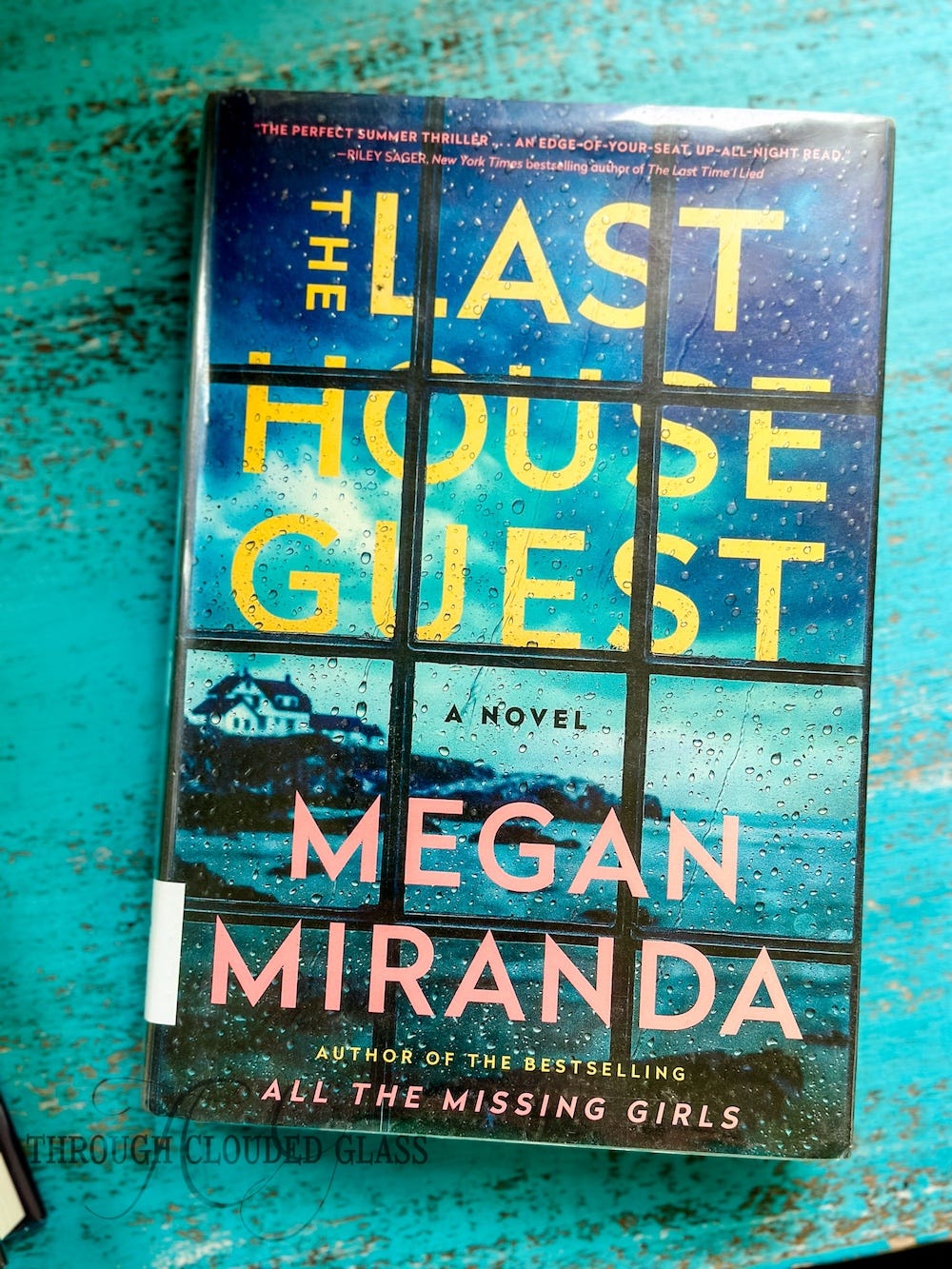
The Last House Guest by Megan Miranda
Avery is a year-round resident of Littleport, Maine, and Sadie is just a summer resident. But one summer Sadie strikes up a friendship with Avery and changes her life…until a few years later when she is found dead, and Avery is left wondering if there was more behind their apparently spontaneous friendship. Megan Miranda always paints such a vivid setting in her books, and the town itself almost becomes a character that affects what all the main characters do - this book was like that as well. If you like small-town suspense, this book was pretty intriguing.
Content Notes: Moderate bad language, two characters sleep together (not described).
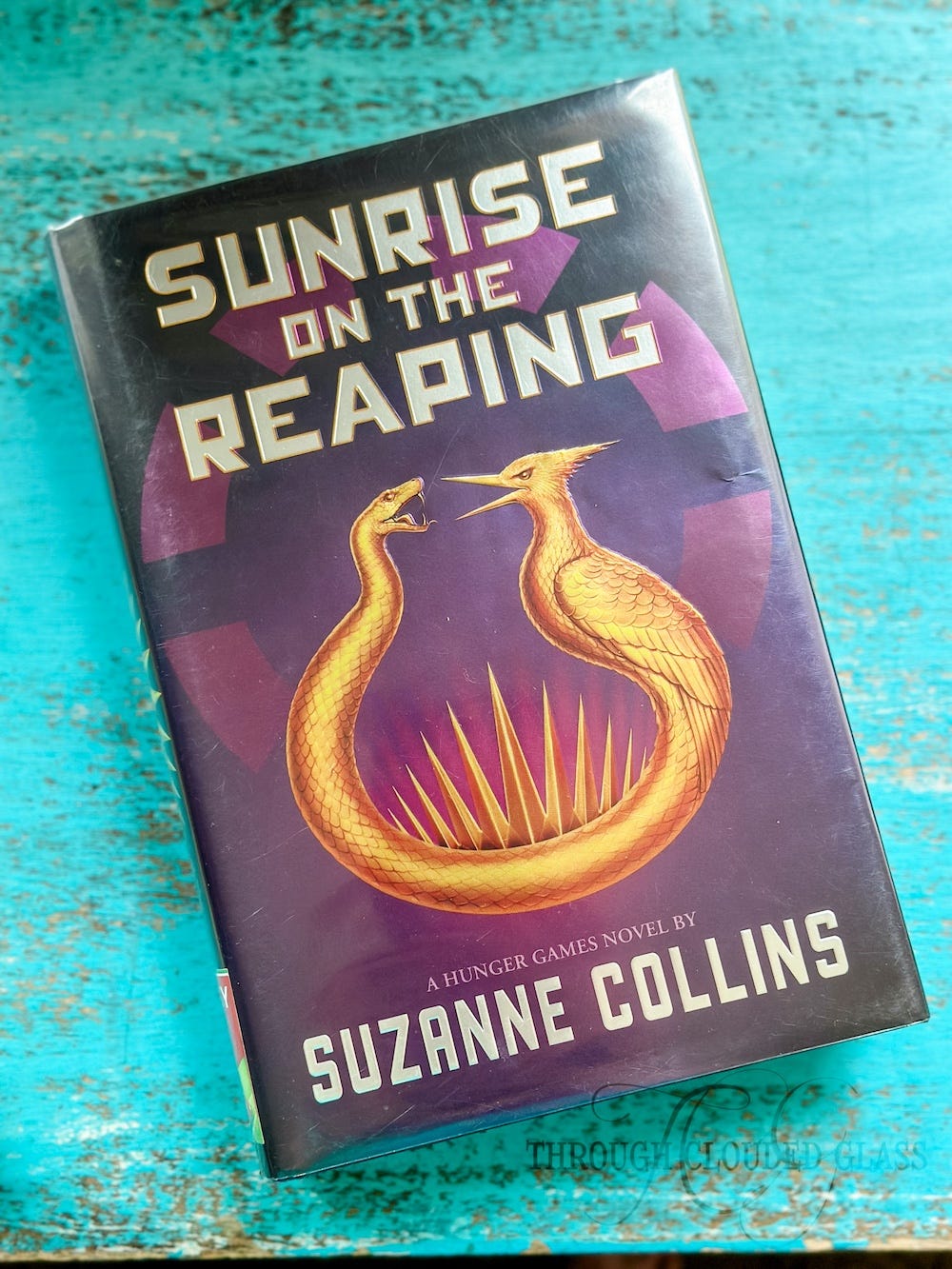
Sunrise On The Reaping by Suzanne Collins
I just read The Ballad Of Songbird And Snakes in order to get this book next. This follows Haymitch’s hunger games - how his family is ripped apart when he is chosen for the games, and the dire consequences he suffers for not playing by the rules. This one made me cry, but I loved how we got a peek into the “ever after” of all the characters from the other books in the last chapter.
Content Notes: Descriptions of violent deaths.
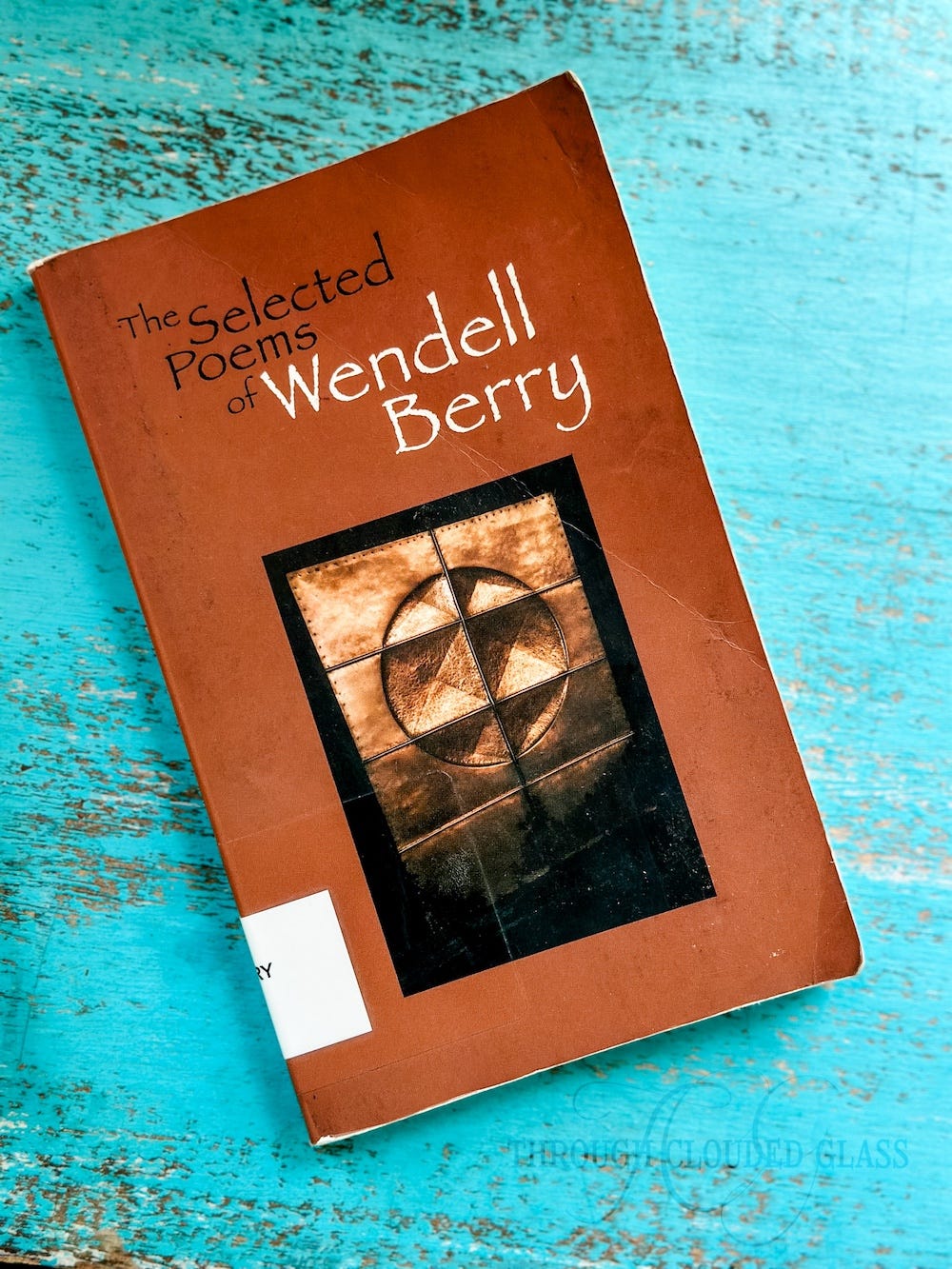
The Selected Poems Of Wendell Berry by Wendell Berry
After reading an article about where to start with reading Wendell Berry, I decided to try picking up a book of his poems. I have tried reading Jayber Crow before, but Berry’s writing style and way of viewing the world is so different from other books I’ve read, I’ve had a hard time getting into it. This poetry collection remedied that for me - I think I understand his philosophy and worldview better just after reading these poems. There were several poems in this collection that I saved to read again later. I will always have a harder time with poetry that doesn’t actually rhyme, but this book went a long way in helping me to see the appeal.
(No photo, I read this next one on Kindle.)
The Watcher Girl by Minka Kent
I needed a quick read for the last stretch of our recent road trip, and this book captured my attention pretty quickly. Grace discovers that her ex-boyfriend has a new family - but he has moved to Grace’s childhood home, married a women that looks alot like Grace, and his daughter is also named Grace. Something weird is going on, and Grace returns to her hometown to figure out what it is. I may have suspected a little bit of where this book was going, but the ending was surprising enough to be satisfying.
Content Notes: Moderate amount of bad language, two characters smoke marijuana.

I’ve got some great books going for my summer reading right now, so keep an eye out for another book roundup soon!

Remember when I said I was going to share books in smaller, more frequent posts this year? Well, 2025 has had different plans, so this is a round-up of everything I've read so far this year, in the order I read them (and I'm in the middle of about ten more books, so stay tuned).
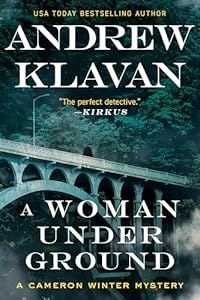
A Woman Underground by Andrew Klavan
I've read the other books in this series, and the thing that makes me keep coming back is the main character, Cameron Winters, a college professor who used to be an assassin for a government agency, and is tortured by the things he has done and by his sad childhood - which he always ends up discussing with his therapist. In this one he must track down his childhood love, who has gone missing and whom he suspects may be in trouble.
Content Notes: Aside from bad language, the main beef I have with this series is that in a few of the books there is pretty graphic violence and brief, sometimes crude descriptions of "adult" situations (ahem). Not every book in the series includes these things, but some have been too explicit for me, and this book was one. Because this series toes that line, I don't necessarily want to recommend it. I only keep picking up the books because I'm invested in the overarching story now, and I skim those pages so I can find out what happens to the main character. I just want him to find happiness, darn it! If this book were a movie I would say it's probably closer to an R rating, and I'm not sure if I'll keep picking them up since the level of the content is iffy for me. I like my books to stay PG-13 or below. (Also, why aren't books rated like movies are? Who do we need to talk to to make this happen?)
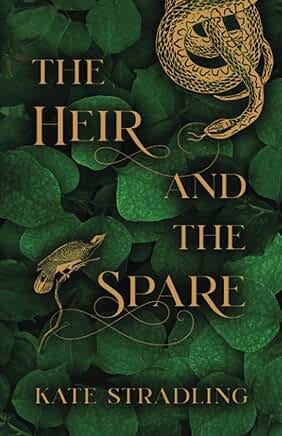
The Heir And The Spare by Kate Stradling
No, this isn't about Prince Harry.
In this fantasy book, Iona is tormented by her evil older sister, Lisenn, who is in line for the Wessett throne. A delegation from nearby Cambria arrives to make a deal for Lisenn's hand in marriage - but Iona is surprised to see that their prince is one of the classmates who tormented her when she was sent away to school. The author explained the political tensions between the different countries in a a really interesting way in this book that didn't feel contrived at all. Those tensions are interwoven with Iona's personal feelings for the prince as they develop from contempt to romance. I really enjoyed it, and this book was also clean!
Content Notes: The only content note I have is {spoiler}, the sister and another important family member end up being quite evil, and there is some death in the end.
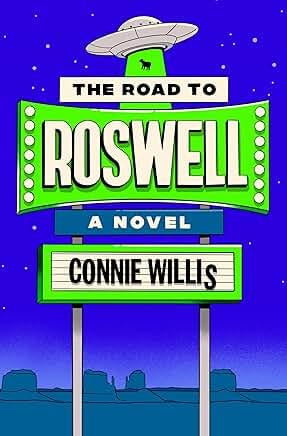
The Road To Roswell by Connie Willis
Francie is traveling to Roswell to talk her best friend out of marrying a UFO nut, when she ends up being kidnapped by an alien! What follows is a wacky road trip with a collection of characters picked up by the extraterrestrial, and it all wraps up in a very satisfying way. I thoroughly enjoyed the entire journey of this book - every character was so quirky and colorful, and the story was creative! This book reminded me of some of the stories my sister and I used to write with our high school friends, but in a grown-up, full-novel way. I loved it.
Content Notes: Some descriptions of skimpy shorts that Francie is forced to wear, mentions of some of the things that aliens do to people in stereotypical alien abduction stories, and some bad language, including Jesus's name in vain.
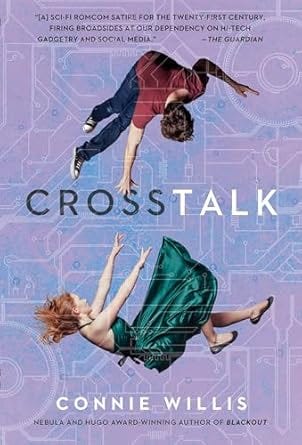
Crosstalk by Connie Willis
After really enjoying the above book by Willis, I picked up Crosstalk. This book is a mix between a rom-com and science fiction - Briddey and her fiancé are going to go through a revolutionary procedure that will allow them to sense each other's feelings but something goes wrong and instead Briddey discovers that a random co-worker can now read her thoughts! The rest of the book is about sorting out this mess. I thought this was a really creative plot, and the ending was very satisfying!
Content Notes: I'd rate this book PG-13 if it were a movie - bad language, and some sexual content (no scenes but talk about it).
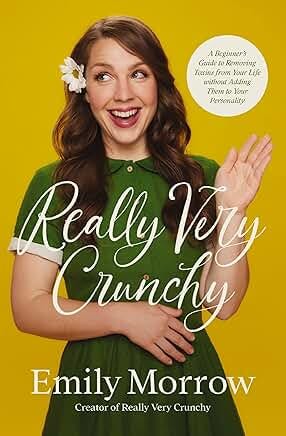
Really Very Crunchy by Emily Morrow
I read this book purely to fulfill a prompt on the reading challenge I am working through this year, which was "a book about health or nutrition". I also follow Emily Morrow on Instagram, so this seemed like an easy introduction to a genre I rarely read. Morrow tells you how to start dipping your toes into being a "crunchy" mom, but with no judgement or guilt and many humorous stories. I wouldn't consider myself crunchy, because I refuse to let myself get stressed out by toxins or pesticides or whatever, but I end up doing alot of crunchy things on accident (homeschooling, canning, sourdough, gardening, trying to buy more clothing with natural fibers). This book gave gentle advice and interesting suggestions and was entertaining, so I give it 4.5 stars.
My Dear Hemlock by Tilly Delahay
This book is inspired by The Screwtape Letters, only in this fresh version, a demon learns how to tempt a female subject. Delahay has so many insights into the female mind, and I found myself convicted at so many points while reading this book - and also amused and encouraged as the woman grows old and ultimately overcomes. If you haven't read The Screwtape Letters, you won't know what to expect, but once you get your bearings this book is fantastic for any Christian reader. Highly recommend.
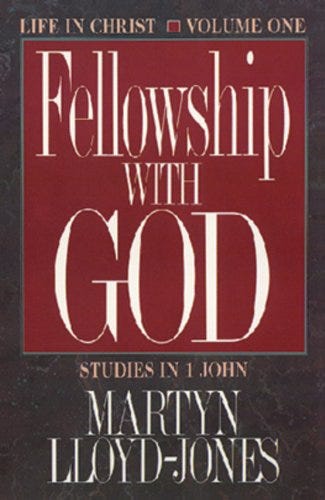
Fellowship With God by Martin Lloyd-Jones
This book was my devotional book this spring, and is based around sermons that Lloyd-Jones preached on 1 John 1. I picked it up because I was doing a study on 1 John at church, and this book provided some additional insight. Lloyd-Jones was a fantastic preacher in his time, and his sermons are so relevant today as well. These thin volumes are not a bad place to start with his writings.
Rembrandt Is In The Wind by Russ Ramsey
I do not know much about art, but I saw this book all over social media last year and I was intrigued. Each chapter talks about a different artist by exploring one of his most famous works, and woven throughout each introduction are deeper themes of faith. Not all these artists are necessarily believers, but Ramsey manages to turn your mind to things above through art appreciation. It was a beautiful book, and probably something I'll have my kids read in future years.
Content Notes: Some mentions of sexual failings of various artists.

A-typical Woman by Abigail Dodds
I won't go into a full review here since I posted my review a couple weeks ago, but this book was another lovely devotional read. One thing I didn't mention in my official review was how thoughtful the chapter on single women was, and it made me think about how so many single women have wonderful wisdom to share with everyone, married women included. I quite enjoyed it, and will probably re-read parts of this book in years to come.
The Ballad Of Songbirds And Snakes by Suzanne Collins
I wasn't a huge fan of The Hunger Games books when I first read them over 10 years ago, but for some reason I became invested in the books/movies again recently and picked up this back-story of President Snow.
I'm not going to lie, this one was dark. I noticed a lot of people online hate it or didn't even finish it. It's not a happy book, but I found it so well-written, and the plot was well-done. This book isn't meant to have a happy ending, but the way Snow's selfishness was woven throughout was masterful. You kept wishing he would recognize the error of his ways, while knowing he wouldn't. You were never rooting for him, which I think was why I didn't mind this book. I don't like when villain backstories attempt to gain sympathy for the villain, but this book didn't do that. We see Snow slide into being a villain through this book, and it all starts with an over-concern with what other people think, pride, and looking out for his own interests over everyone else, even the girl he fools himself into thinking he loves. For me, this book provides a vivid picture of the deceitfulness of sin. Not sunshine-y, but impactful in its own way.
Content Notes: Some pretty gruesome violence.
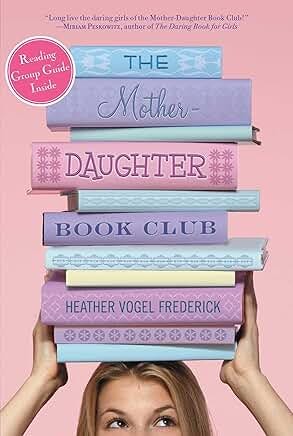
The Mother Daughter Book Club by Heather Vogel Frederick
This book follows four 6th graders as their mothers force them to participate in a book club reading Little Women. I picked up this book to see if my 12 year old might like it, since the characters in the book are about the same age. I think there is too much drama surrounding boy characters for me to want to hand it to my daughter right now. That said, I quite enjoyed it, and it reminded me of what it's like to be a middle school girl - in good and bad ways. Middle school is the worst.
Content Notes: Nothing serious, but a large focus on boys, lots of drama, and one very tomboyish character with some feminist plot lines.
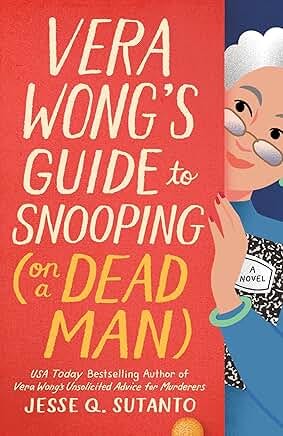
Vera Wong’s Guide To Snooping (On A Dead Man) by Jesse Sutanto
In this book Vera Wong returns as she stumbles upon another apparent suicide that she suspects is murder - and she eventually gets the truth with her relentless spirit, and lots of mouthwatering food. Vera Wong is a very colorful character, one you can't easily forget and can't help but enjoy.
Content Notes: Bad language, including the f-word, and the author is clearly a liberal socially. Not too in-your-face, just annoying mentions of different issues.
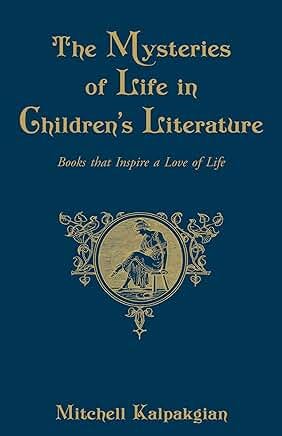
The Mysteries Of Life In Children’s Literature by Mitchell Kalpakgian
Andrew Pudewa recommends this on his reading list for educators, so I finally picked it up. Each chapter addresses a different theme that is explored in children's literature, with a heavy focus on fairytales. We learn how classic children's literature teaches about the mysteries of love, children, home, friendship, etc. This is a great introduction to some of the symbolism in certain stories that may otherwise seem too weird or go over one's head - but I could see as I read each chapter how children would still get the message, even though these "lessons" are never outright explained. And teaching through a story can be more effective than just making statements, can't it? Sometimes the writing got a little repetitive or felt like an academic essay, but the points were sound.
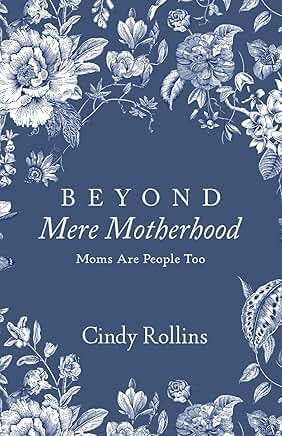
Beyond Mere Motherhood by Cindy Rollins
I try to read a homeschool book every year, and though I know Mere Motherhood is supposed to come first, I was glad I read this one. This book is like a conversation with an older homeschool mom about varying aspects of being a mother - being a thinking mother, a healthy mother, a reading mother, and many others. A lot of gentle encouragement in this book, and a lot of leads for other books I may want to read. I didn't agree with Rollins about everything, but the overall feeling I got from this book was of a kindly older woman, trying to share her experience even though she didn't do it all right. Very down-to-earth.
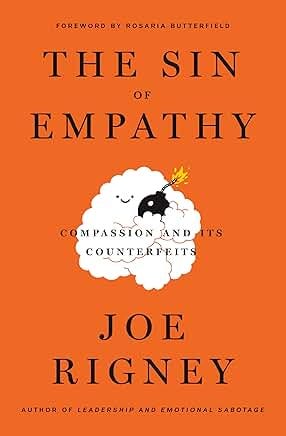
The Sin Of Empathy: Compassion And It’s Counterfeits by Joe Rigney
I listened to this book in one day while I cleaned my house and planted trees in my yard. Rigney talks about the sort of empathy that becomes dysfunctional, and how it can affect relationships and especially the environment in churches. I recognized so much of what he was talking about from my own experiences. I will probably listen to this book again, or read it more slowly, because there were so many good insights. I would say this book was more about diagnosing the problem than providing step-by-step solutions, but I thought his call in the last chapter to imitate Christ was impactful. As I said, I think I need to read it again to absorb it more fully.
Chernobyl's Wild Kingdom by Rebecca L. Johnson
I am reading another book related to nuclear disaster, so I decided on a whim to pick up this short book for kids - and oh my, I learned so much. This book gives a brief summary of nuclear power and the Chernobyl disaster, and then focuses on what has happened in the Exclusion Zone since then. The Exclusion Zone is an area that is restricted around Chernobyl because it still has high levels of radiation. Scientists expected that this zone would become a lifeless wasteland, but instead plants and animals have appeared to thrive there - like a radioactive nature preserve. The author talks about different theories about how the animals are being affected by the radiation, or why some of them appear not to be affected as much or at all. It was a short read, I read it in under an hour, but it was so fascinating! If you are interested at all in Chernobyl you should pick this one up.
That’s all for now!
















